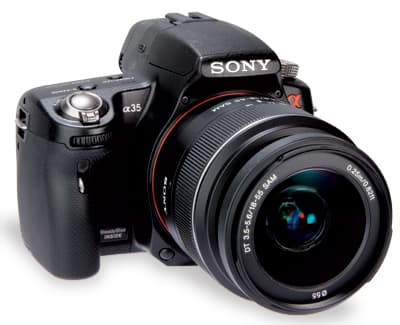At the AP Awards 2011, Sony won the Innovation of the Year award for its translucent mirror system technology fitted to its Alpha 33 and Alpha 55 cameras. The company has now announced its eagerly anticipated follow-up in the form of the Alpha 35, which replaces the discontinued Alpha 33 ? the cheaper of the two cameras in this range.
The most noticeable improvement over the Alpha 33 is the 16.2-million-pixel sensor fitted to the Sony Alpha 35. It is the same sensor found in the NEX-C3 (see left), and a two-million-pixel increase from the Alpha 33. Despite the sensor having the same number as pixels as that fitted in the Alpha 55, Sony states that the new model is a refined version. This almost certainly suggests that when the replacement for the Alpha55 arrives, it will increase the resolution further still.
However, it is the way that the Sony Alpha 35 benefits from its translucent mirror system technology that is the key point of interest. The frame rate of the Alpha 35 is 7fps, which is the same as that of the Alpha 33. An improvement to the continuous shooting is the new tele-zoom high-speed shooting, which magnifies the central portion of the image by 1.4x and enhances the performance of continuous tracking AF.

There are several new picture modes, including toy camera, high key and retro photo, all of which can be used for both still and moving images. These are available for the Alpha 33 and 55, too, via a new firmware upgrade.
As with the first-generation models, my first impressions of the Sony Alpha 35 have been good. There is little to distinguish the Alpha 35 from its predecessor, because its size and intuitive button layout is identical. At 473g including battery and memory card, it is marginally lighter. Thanks to the contoured grip, the Alpha 35 sits nicely in the hand and feels well balanced. However, I am a little surprised to see that the LCD screen is now fixed, rather than being fitted with the vari-angle of the Alpha 33, and there were times when I missed having this feature. Some may consider fitting a fixed LCD screen to be a backwards step, but Sony states that the fixed screen has been fitted to keep the costs down.

Other improvements include an improved battery life of 440 shots from a full charge, which is a 100-shot increase over the Alpha 33 and 60 shots more than the Alpha 55. This is a marked improvement, and certainly one that is welcome considering the key selling points for this camera are its continuous shooting, fast frame rates and high-performance video.
An initial look at my images shows that the 16.2 million-pixel sensor of the A35 is very capable at resolving good levels of detail. Furthermore, I am particularly impressed with the quality in low light.
As the Sony Alpha 35 seems to be encroaching on the specifications of the Alpha 55, it will be interesting to see what changes Sony makes with the replacement for the Alpha 55.
At the time of going to press Sony had not released a launch date or price for the Alpha 35, but the fixed screen should make it an even more affordable option for the keen action photographer than the Alpha 33.
See AP 2 July for a full test of the Sony Alpha 35








